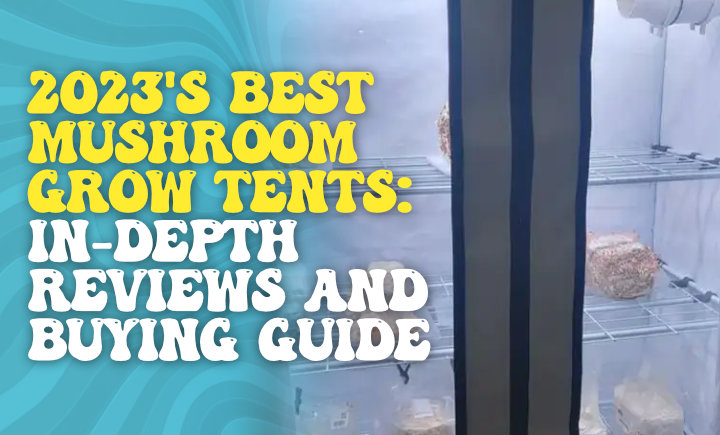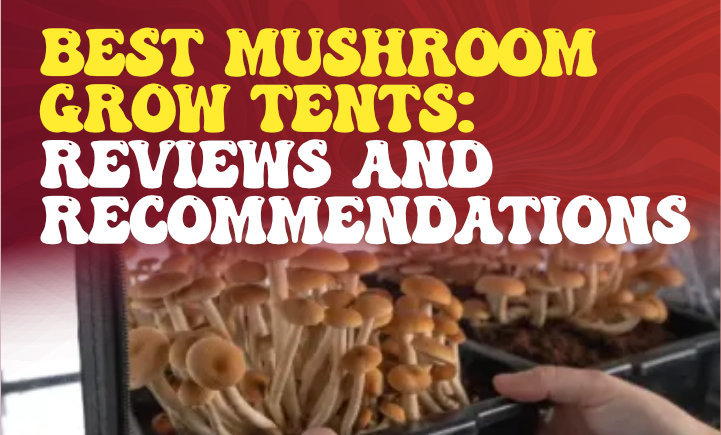2023’s Best Mushroom Grow Tents: In-Depth Reviews And Buying Guide
- City Guide
- Magic Mushrooms
-
Jul 26
- Share post

Growing mushrooms can be a complex yet rewarding process. It requires precision, the right environment, and most importantly, a suitable grow tent to ensure optimal growth and yield.
To simplify this process, we’ve compiled an in-depth guide reviewing the best mushroom grow tents available in 2023. We’ll cover everything from small grow tents for hobbyists to DIY options for those who prefer a hands-on approach.
Additionally, you can also find tips on how to build your own mushroom grow tent, along with techniques for maintaining the perfect conditions within it.
So whether you’re just starting or are an experienced mycologist looking to upgrade your setup, this guide will give you valuable knowledge and insight.
Benefits of Using a Mushroom Grow Tent
You’re probably wondering, ‘What’s the big deal about using a mushroom grow tent?’ Well, it’s got a ton of benefits that’ll boost your mushroom farming game!
Mushroom cultivation at home can be tricky due to factors like maintaining proper humidity levels and airflow. This is where the benefits of using a mushroom grow tent come into play. A well-designed tent provides an ideal environment for your mushrooms to thrive, ensuring they get the right amount of light, temperature control, and air circulation they need.
One major advantage is that these tents have features that help maintain optimal growing conditions. For instance, many models have built-in ventilation systems to regulate fresh air exchange – which is crucial in preventing mold growth and promoting healthy mycelium expansion. Some tents even come with adjustable humidity and temperature settings that allow you to create the perfect micro-climate for different types of mushrooms.
More than just providing an excellent growing environment, another key benefit lies in their convenience and efficiency. Often compact in design, these tents fit seamlessly into any space – be it your backyard or basement – allowing you to cultivate high-quality mushrooms irrespective of external weather conditions or seasonal changes. These factors combined make a mushroom grow tent an invaluable tool for both beginners looking to try their hand at home-based cultivation as well as seasoned hobbyists seeking consistent results year-round.
Factors to Consider When Choosing a Mushroom Grow Tent
When selecting the ideal tent for your fungi cultivation, there are several key factors you’ll need to take into account. Mushroom grow tents aren’t a one-size-fits-all solution; rather, they need to cater to the specific needs of both the mushroom growers and the types of mushrooms being cultivated. Our buying guide aims to help you navigate through these considerations with ease, allowing you to make an informed choice that will improve your mushroom growth.
1. Size: Consider how much space you have available for your growing setup and how many mushrooms you plan on cultivating. Larger tents allow for greater yields but consume more energy and require more maintenance.
2. Material: The tent material should be durable, light-proof, and waterproof to provide an optimal environment for mycology.
3. Ventilation: Proper airflow is crucial in preventing mold growth while maintaining necessary humidity levels.
4. Ease of assembly: Look for a tent that is easy to set up and dismantle as this will save valuable time and effort.
Understanding these factors can largely influence your success as a mushroom grower. For instance, if you’re growing larger species or planning a commercial operation, a small tent simply won’t do — size does matter in this case! Similarly, choosing a poorly ventilated tent could lead to disastrous mold infestations ruining entire batches of mushrooms — not something we’d wish on any cultivator!

Best Mushroom Grow Tents: Reviews and Recommendations
Diving into the world of mushroom cultivation, it’s essential to equip yourself with top-notch gear that’ll amplify your efforts and maximize yields. A critical component is a quality mushroom grow tent. These tents provide a controlled environment that is ideal for mushroom growth, offering optimal lighting, temperature, and humidity conditions.
With the myriad options available out there, picking one can be challenging; hence we’ve decided to share our reviews and recommendations on 2023’s best mushroom grow tents to make your buying decision easier.
Bearing in mind factors like durability, size, assembly ease, and cost-effectiveness, here are some brands that stand out:
The first worthy mention is the ‘Mycelium Majesty Mushroom Grow Tent’. This tent boasts heavy-duty zippers ensuring longevity and a reflective interior enhancing light distribution. More so, its ventilation system allows for efficient air exchange – crucial for productive mycelium growth.
Another great option is the ‘FungiFarm Deluxe Grow Tent Kit’. It comes complete with an adjustable lighting system as well as a hydration mechanism designed specifically for mushrooms’ unique water requirements.
Another good pick is the ‘ShroomBox Pro’, renowned for its user-friendly design. What sets it apart from many other models is its smart control panel that lets you adjust environmental parameters digitally – adding convenience while ensuring precision required by mushrooms at different stages of their life cycle. As part of this grow tent kit, you also get detailed instructions about setting up the tent and tips on how best to use it for maximum yield which makes it perfect, especially if you’re new to mushroom cultivation or have had limited success before now.
Small Grow Tents
If you’re tight on space but still fancy dabbling in indoor gardening, small grow tents could be the answer. These compact units are a perfect solution for those who want to cultivate their own mushroom farm without turning an entire room into a horticultural haven.
Small grow tents come in various sizes, meaning they can fit into most spaces – from closets to corners of your living room or garage. They’re easy to set up (some even come with DIY assembly instructions) and generally cheaper than their larger counterparts.
Notably, one feature that stands out regarding small grow tents is the use of mylar on their interior surfaces. Mylar is a reflective material that maximizes light distribution within the tent, ensuring all your mushrooms receive equal exposure and promoting healthy growth rates.
Furthermore, these grow tents also provide optimal conditions for mushroom growth by maintaining temperature and humidity levels more effectively than open-air setups. This feature makes them ideal for those new to mushroom farming as it reduces the risk of cultivation issues related to environmental factors.

DIY Grow Tents
So you’re thinking about getting your hands dirty and building your own DIY tent for indoor gardening? That’s fantastic! Mushroom grow tents are an excellent way to cultivate your favorite fungi in a controlled environment. They provide the high humidity that mushrooms need, protect them from pests, and allow for precise control over growing conditions. The best part is, you can customize your DIY grow tent to be perfectly suited to your individual needs. Whether it’s a mini greenhouse or a full-sized grow room, we’ve got some tips that will help guide you on this exciting venture.
Choosing Your Space:
First of all, decide where you want to set up your mushroom grow tent. This could be anywhere from a spare bedroom, basement, garage, or even a closet – as long as there’s enough space for the size of the tent you have in mind.
Materials Needed:
Depending on the size of your DIY grow tent, materials may vary but generally include PVC pipes (for frame), reflective material like Mylar (to increase light efficiency), zipper (for easy access), and duct tape or glue (for joining parts).
Installation:
Setting up involves creating a frame using the PVC pipes; then covering it with Mylar using duct tape or glue. Don’t forget to install a door using the zipper for easy access into the tent.
Now let’s talk about lighting and humidity – two key factors in successful mushroom cultivation. For lighting inside your DIY grow tents, consider installing LED lights which are energy efficient and generate less heat compared to other types of lights – very important when maintaining optimal temperatures within our mini-greenhouse! As for maintaining high humidity levels necessary for mushrooms’ growth cycle – meet this game changer: the humidity controller! This device automates humidification ensuring consistent conditions throughout your mushroom’s life cycle without constant manual adjustments.
Mushroom Grow Tents
Mushroom grow tents, specifically designed for accommodating the unique needs of different mushroom species, are becoming increasingly popular. One common model is the ‘martha tent,’ named for its resemblance to Martha Stewart’s clothes drying setup. However, these aren’t your average camping tents; they’re often equipped with specialized features such as humidity control and air filtration systems – essential components when creating an ideal mushroom fruiting chamber.
Creating an automated mushroom growing environment within a tent involves several steps. First, you’ll need to introduce spawn (baby mushrooms) into a substrate (the material in which mushrooms grow). Depending on the species you’re growing – be it shiitake, oyster, or even lions mane mushrooms – different substrates may be more suitable than others.
For example, lion’s mane mushrooms tend to prefer hardwood substrates like oak or maple. The substrate is typically placed inside bags or containers and then positioned within your martha tent where temperature and humidity can be carefully controlled to encourage growth.
Best Grow Tents for Beginners
Dipping your toes into the world of indoor gardening can be quite a thrilling endeavor, especially when you’re starting with beginner-friendly options.
One such option is mushroom cultivation using hydroponic grow tents. Hydroponics is an efficient method that uses water and nutrient solutions to cultivate plants without soil. It’s perfect for the growth of oyster mushrooms, which thrive in moist environments. By utilizing a tent specifically designed to create optimal growing conditions, it’s easier to produce bountiful harvests regardless of outdoor weather.
A good starter kit will typically include grow bags filled with fruiting blocks – these are substrate materials infused with mycelium (the vegetative part of a fungus). The mycelium colonizes the substrate and eventually produces mushrooms under the right conditions.
Additionally, having LED lights inside your tent can greatly promote growth as they provide the necessary light spectrum for photosynthesis. Mushroom spores require specific light spectrums to sprout effectively, making LED lights an essential component in every beginner’s grow tent.
To ensure success in your first venture into mushroom farming, it’s crucial to choose a high-quality grow tent designed for beginners. Look for features like ease of assembly and disassembly, durability, effective air circulation systems, and observation windows that allow you to monitor growth progress without disturbing the internal environment.
How to Build a Mushroom Grow Tent
Building your own mushroom grow tent isn’t as daunting as it may seem; with a little patience and dedication, you’ll be growing medicinal mushrooms like lion’s mane in no time!
To start, you’ll need a few key materials:
– A spacious plastic tub or container: this will serve as the main body of your ‘monotub’. Make sure there are no cracks or holes other than what you purposely create.
– An ultrasonic humidifier: maintaining humidity is crucial for mushroom growth. The north spore variety especially thrives in moist conditions.
– Blackout material (like thick fabric or plastic): this keeps light out, allowing you better control over light exposure.
Now that you have gathered all necessary items let’s get crafting! First, cut out three sides of the tub leaving one side intact to create an opening. Then, line the interior with blackout material ensuring that light cannot penetrate through any gaps.
Next up is installing the ultrasonic humidifier – it should go on one end of the monotub with its nozzle pointing towards the center. It will provide optimal moisture levels essential for producing lush crops of mushrooms.
Remember – patience is important when cultivating fungi at home; they require time to grow and mature properly. However, once complete, your homemade grow tent offers an exceptional platform for experimenting with different types of mushrooms under controlled conditions.
Mushroom Growing Setup: Tips and Techniques
One essential tool for mushroom cultivation is an all-in-one fogger. This device helps maintain the high humidity levels required by most mushroom species. It disperses tiny water droplets throughout the environment, preventing dry spots where mushrooms might not grow well. When choosing a fogger, look for one with a warranty – this ensures that if anything goes wrong, you’ll be able to get a replacement or repair.
Proper filtration is another critical aspect of mushroom growing setup. Mushrooms produce a lot of spores which can clog up your ventilation system and make it less effective over time. To prevent this, we recommend using ducting with built-in filters designed specifically to catch these spores before they reach your fan or other ventilation equipment. Don’t forget to clean or replace these filters regularly to ensure they remain efficient and don’t hinder airflow.
Maintaining Proper Environment in a Mushroom Grow Tent
Maintaining the right environment within your tent is crucial for successful fungi cultivation, and it’s more than just about humidity and temperature. It’s about creating a controlled microclimate that mimics the conditions in which mushrooms naturally thrive.
Here, we’ll delve into how to establish and maintain these conditions in a grow tent setup.
To maintain an optimal environment inside your mushroom grow tent, several factors need attention:
– Air Exchange: Mushrooms release carbon dioxide as they grow, necessitating regular air exchanges to provide fresh oxygen. Without proper ventilation, their growth can be stunted or even halted.
– Lighting: While mushrooms aren’t photosynthetic like plants, they still require some light for healthy development. A dimly lit environment is often enough.
– Humidity: High humidity levels are paramount for mushroom growth. Keeping a consistent level of moisture helps stimulate fruiting and prevents drying out.
– Temperature Control: Different species of mushrooms thrive at different temperatures. Maintaining appropriate heat levels based on the type you’re growing is crucial.
Remember that managing these environmental elements requires vigilance and consistency. Some growers might get tempted to take shortcuts or ignore one aspect over another, but each factor plays its part in ensuring a bountiful harvest from your grow tent. Regular monitoring using tools such as hygrometers (for humidity) or thermometers (for temperature) can help keep things in check.
Keeping all these aspects balanced ensures that your fungi have everything they need to flourish without stress or stunting—much like maintaining any other living ecosystem, patience and attention to detail pay off here too.
And while it may seem complex at first glance, once you’ve got the hang of it, keeping up with your mushroom grow tent becomes second nature—a rewarding hobby that brings fruitful results!
Final Thoughts
The importance of choosing the right grow tent cannot be stressed enough. We have explored various factors such as size, durability, ventilation, and ease of use to help you make an informed decision.
As the demand for mushrooms continues to grow, having a reliable and efficient grow tent is essential for both commercial and hobbyist growers. With the information provided in this article, growers can confidently make a well-informed purchase, ensuring a successful and bountiful mushroom cultivation experience in 2023 and beyond.
Frequently Asked Questions
What is the best mushroom growing container?
The best mushroom growing container can vary depending on the specific type of mushroom you are growing. However, commonly used containers include plastic bags, buckets, or trays with proper ventilation and drainage.
How do you heat a mushroom tent?
Heating a mushroom tent can be done using various methods such as electric heaters, heat mats, or even using a heating system integrated into the tent itself. The specific method will depend on the size of the tent and the heating requirements of the mushroom species being grown.
What is a mushroom grow room called?
A mushroom grow room is commonly referred to as a mycology lab or a cultivation facility. It is a controlled environment designed for optimal mushroom growth, typically equipped with specialized equipment like climate control systems, grow lights, and sterilization tools.
How do you start a mushroom grow room?
To start a mushroom grow room, you need to first choose a suitable location with proper temperature, humidity, and ventilation control. Then, set up the necessary equipment such as grow shelves, lighting, humidity control devices, and air filtration systems. Finally, introduce the desired mushroom species by inoculating the growing medium with spawn or mycelium.
